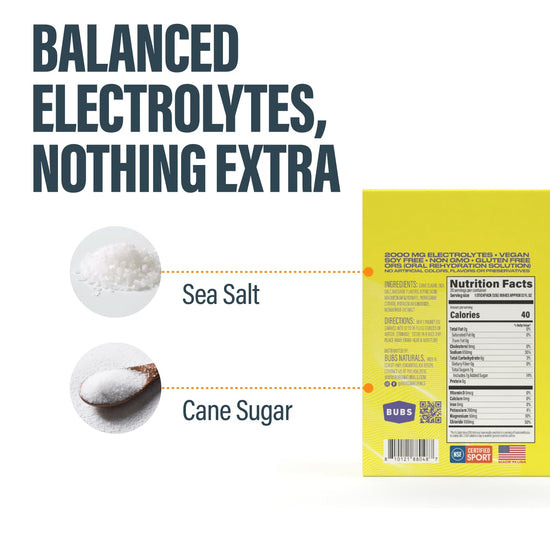Table of Contents
- Introduction
- Understanding Electrolytes and Their Importance
- Ingredients for Homemade Electrolyte Powder
- How to Make Your Own Electrolyte Powder
- Why Choose Homemade Over Store-Bought?
- The BUBS Difference: Supporting Your Wellness Journey
- Conclusion
Introduction
Have you ever felt completely drained after a long run or a day in the sun? That fatigue might not just be from physical exertion; it could be a sign of depleted electrolytes. Electrolytes, essential minerals that carry an electric charge, play a crucial role in maintaining our body's fluid balance, supporting muscle function, and ensuring proper nerve signaling. For those of us who lead active lifestyles, knowing how to replenish these vital nutrients is key to staying energized and healthy.
At BUBS Naturals, we are committed to adventure, wellness, and giving back, inspired by the legacy of Glen “BUB” Doherty. We believe in providing clean, effective supplements that support an active lifestyle, and our products reflect this no-BS approach. Today, we’re diving into the world of homemade electrolyte powder, exploring its benefits, how to make it, and how it aligns with our mission to support your wellness journey.
By the end of this post, you will not only understand the importance of electrolytes but also learn how to create your own electrolyte powder at home. We will cover:
- The essential role of electrolytes
- The ingredients needed for homemade electrolyte powder
- Simple recipes to get you started
- Tips for customizing your mix to suit your taste and needs
Let’s embark on this journey to hydration and wellness together!
Understanding Electrolytes and Their Importance
Electrolytes include sodium, potassium, calcium, magnesium, and chloride. These minerals are crucial for:
- Fluid Balance: Electrolytes help regulate the amount of water in your body, ensuring that your cells stay hydrated.
- Muscle Function: They are essential for muscle contractions. A lack of electrolytes can lead to cramps and weakness.
- Nerve Function: Electrolytes are key in transmitting electrical signals in the nervous system, affecting everything from reflexes to heartbeats.
The balance of electrolytes in our body can be disrupted through sweat, illness, or even a poor diet. By learning how to make your own electrolyte powder, you can take control of your hydration and recovery.
Ingredients for Homemade Electrolyte Powder
Creating your own electrolyte powder at home is a straightforward process. Here’s what you’ll need:
Base Ingredients
- Sodium Chloride (Table Salt): Provides sodium, which is vital for fluid balance and muscle function.
- Potassium Chloride: Essential for nerve function and helps maintain a healthy blood pressure.
- Magnesium: We recommend magnesium citrate or magnesium glycinate for better absorption.
Optional Ingredients
- Flavorings: Natural fruit powders, citrus juice, or essential oils (like lemon or lime) can enhance taste.
- Sweeteners: Honey, stevia, or maple syrup can be added for sweetness, depending on your preference.
- Bicarbonate of Soda: Can be included for additional alkalinity and flavor.
Recommended Ratios
Here’s a basic recipe to get you started:
- Sodium Chloride: 2,500 mg
- Potassium Chloride: 385 mg
- Magnesium (citrate or glycinate): 390 mg
Mixing these in the right proportions ensures that you achieve a balanced electrolyte profile similar to that of commercial sports drinks.
How to Make Your Own Electrolyte Powder
Step-by-Step Instructions
- Measure Your Ingredients: Use a kitchen scale for accuracy. If you don’t have one, you can convert the measurements to teaspoons, but this may not be as precise.
- Combine Ingredients: In a bowl, mix the sodium chloride, potassium chloride, and magnesium thoroughly until evenly distributed.
- Add Flavor and Sweeteners (Optional): If you want to enhance the taste, add your chosen flavoring and sweetener. Start with a small amount and adjust to your taste preference.
- Store in an Airtight Container: Place the mixture in an airtight jar or container, labeling it with the date and serving size.
- To Use: When you're ready to hydrate, mix 1/4 teaspoon of the powder into 16-32 ounces of water. Shake or stir well before drinking.
Customization Tips
- Flavors: Experiment with different flavors using fruit powders or citrus juices. Adding a few slices of fresh lemon or lime can also provide a refreshing twist.
- Sweetness: Tailor the sweetness to your liking. If you're avoiding sugar, consider using stevia or a similar natural sweetener.
Why Choose Homemade Over Store-Bought?
Making your own electrolyte powder has several advantages:
- Cost-Effective: Homemade mixes are often significantly cheaper than commercial products.
- Control Over Ingredients: You can avoid artificial additives and preservatives often found in store-bought options.
- Customization: Tailor your powder to meet your personal taste and dietary preferences.
At BUBS Naturals, we understand that maintaining control over what you consume is essential, especially for those who prioritize clean, functional nutrition.
The BUBS Difference: Supporting Your Wellness Journey
While making your own electrolyte powder is a fantastic way to ensure you’re getting the nutrients you need, we also offer a range of high-quality, science-backed supplements to support your active lifestyle. For instance, our Hydrate Electrolytes collection is designed to provide full-spectrum mineral support with no added sugar, making it a perfect companion for workouts or outdoor adventures.
We emphasize our commitment to the 10% Rule, donating 10% of our profits to veteran-focused charities in honor of Glen “BUB” Doherty's legacy. When you choose BUBS Naturals, you’re not just investing in your health; you’re also giving back to those who have served our country.
Conclusion
Understanding how to make your own electrolyte powder is a valuable skill that can enhance your hydration and overall health. By using simple, natural ingredients, you can create a refreshing drink that meets your personal taste and nutritional needs.
With the added benefits of economic savings and ingredient control, we hope you feel empowered to try this at home! And remember, while homemade options are fantastic, BUBS Naturals is here to support your wellness journey with our clean, effective products.
Explore our full range of products to discover how we can enhance your hydration and overall well-being!
FAQ
1. How often should I consume electrolyte drinks?
Electrolyte drinks are particularly beneficial during and after intense physical activity or hot weather. However, they can also be a good addition to your daily hydration routine.
2. Can I use my homemade electrolyte powder every day?
Yes, you can use it daily, but be mindful of your total mineral intake to avoid imbalances.
3. What are the signs of electrolyte imbalance?
Symptoms can include fatigue, muscle cramps, dizziness, and irregular heartbeats. If you experience these, consider increasing your electrolyte intake.
4. Is it safe to make my own electrolyte drinks?
Absolutely! As long as you follow recommended guidelines for ingredient proportions and maintain good hygiene during preparation.
5. Can I travel with my homemade electrolyte powder?
Yes! It’s convenient to pack and can be mixed with water wherever you go. Just be sure to store it in an airtight container.
By making your own electrolyte powder, you’re not only fueling your body effectively but also embracing a healthier lifestyle choice. Let's raise a glass to hydration and wellness!
Written by:
Bubs Naturals

Hydrate or Die
When you’re sweating hard—whether it’s from a tough workout, a long day in the sun, or just life—your body needs more than water to stay balanced and energized.
Hydrate or Die® delivers 2,000 mg of electrolytes in every serving to help you rehydrate faster, fight off fatigue, and keep going strong. That includes the right mix of sodium, potassium, and magnesium to support muscle function, prevent cramps, and maintain energy levels.
With a small dose of natural cane sugar to speed up absorption, this clean, easy-to-use powder is made for real performance—not just flavor.
Starts at $29.60
Shop

